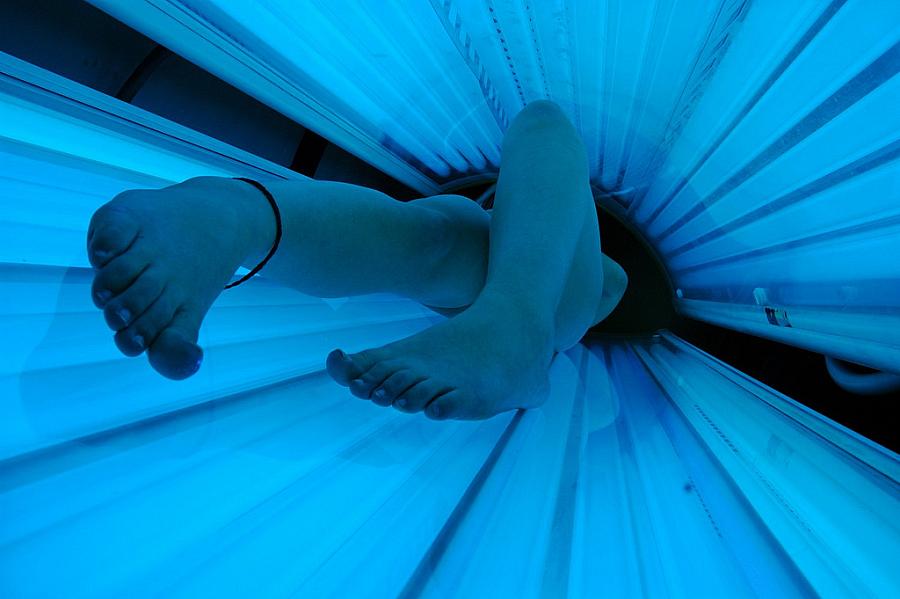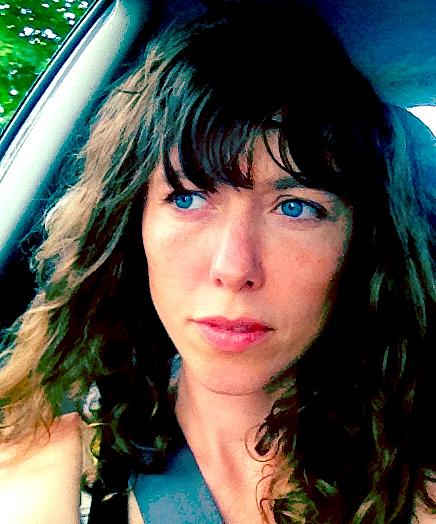Q&A with Bridget Huber: How the Indoor Tanning Industry is Selling a "Sun Scare" Conspiracy

Journalist and public health graduate student Bridget Huber last week published a compelling account of how the indoor tanning industry is demonizing physicians and others who warn of tanning's dangers as part of a grand conspiracy. Here's an excerpt from her story, published at FairWarning.org and in Mother Jones:
At the heart of the industry’s message is the idea that tanning critics such as dermatologists, sunscreen manufacturers and even charities like the American Cancer Society are part of a profit-driven conspiracy. These critics are described as a “Sun Scare industry” that aims to frighten the public into avoiding all exposure to UV light. The tanning industry blames this group for causing what it calls a deadly epidemic of vitamin D deficiency, and tries to position itself as a more trustworthy source of information on tanning’s health effects.
In an email interview, Huber, a staff writer for FairWarning.org and a University of California-Berkeley public health graduate student, talked about how she reported her story. Our interview has been edited for length and clarity.

A: Last February, Democrats on the House Energy and Commerce Committee put out a report that found salon employees were miscommunicating the risks of indoor tanning. My editors asked me to look into the issue in June because they felt the report hadn't gotten as much media coverage as it might have, considering how surprising some of the findings were. For example, the committee's investigators called 300 salons posing as fair-skinned teens and 90 percent of the salon staff they spoke with said indoor tanning posed no health risks.
To be perfectly honest, I was skeptical that there was much of a story here since the report, while fascinating, was months old by the time I saw it. But as I started to spend some time reading trade magazines, I realized the industry was doing and saying some pretty extreme and misleading things that appeared to be flying under the radar.
Q: Had you covered these issues before? What interested you about the story?
A: I've written on health issues before, but never on the tanning industry. But I am generally drawn to stories that expose that gap between what powerful or wealthy players say and what they actually do. The industry's audacity was remarkable — it's woven an entire narrative that demonizes physicians and cancer charities and undermines the mainstream medical consensus that indoor tanning increases cancer risk. I also loved untangling the relationships between the many Vitamin D advocacy groups that appear to be independent non-profits but have strong, but often undisclosed, ties to the industry.
Q: Have you ever used a tanning booth yourself? If so, what was it like?
A: I never have. I did consider it when reporting this story, just to have the first-hand experience. But I'm a freckle-face and the statistics are pretty sobering: a University of Minnesota study found people who'd tanned indoor have a 74% greater risk of developing melanoma than those who have never been in a sunbed. I decided to sit this one out.
Q: You mention that indoor tanning is a $4.9 billion industry – where did you get that number?
A: That figure comes from the market research firm IBISWorld. One thing to note about that figure, too, is that it only includes tanning salons. So, it doesn't take into account the companies that make and sell sunbeds, lamps, lotions, goggles, etc. So, the broader industry is actually even bigger, overall, though I couldn't find a solid figure quantifying its size.
Q: How easy or hard was it to get reliable data on the tanning industry?
A: Well, luckily IBISWorld had great and recent data on the industry. Pinning down statistics about the incidence and risk of melanoma was trickier, since there are a lot of studies and they don't all say the same thing. I tried to cite only large studies. And I also asked researchers to help me judge the merits of a couple of papers, since it can be difficult for a non-scientist to evaluate these studies.
Q: That's a striking picture of Chelsea Price's melanoma scar – how did you find people who were negatively affected by indoor tanning?
A: I found Chelsea on Facebook — she'd posted on the Melanoma Research Foundation's page, so I messaged her. I also posted general call-outs to the foundation's message board and Facebook page, which prompted Lisa Graubard, the former salon employee I quoted, to get in touch. The American Academy of Dermatology also provided me with a list of melanoma survivors and physicians; that's how I connected with Meghan Rothschild and Dr. Bruce Brod.
Q: You and your sources likened the tanning industry's push against safety warnings to the cigarette industry trying to promote its products as safe – could you expand on that comparison?
A: There are a few parallels. First, both are industries that are trying to defend and continue to sell products that have been widely deemed as harmful. One strategy they've both used is to try to cast doubt on the science behind the health warnings about tanning and smoking.
For example, the tanning industry continues to insist the relationship between melanoma and indoor tanning still isn't understood and to deny the reports that melanoma cases are on the rise among young women, who are the primary customers of tanning salons. But the mainstream medical consensus is that indoor tanning significantly increases risk of melanoma and that melanoma rates have risen dramatically among young white women since 1980.
Another thing that's apparent is the indoor tanning industry's attempt to shift the conversation from the health risks of indoor tanning to its purported health benefits. Cigarette companies used to market their brands as less irritating and use images of doctors to give their products a veneer of healthfulness. Similarly, the tanning industry has been pushing the message that sunbeds are good sources of vitamin D which they say will prevent diseases ranging from breast cancer to autism.
Finally, the tobacco industry funded and created a web of non-profit research and advocacy groups that defended the industry but gave the appearance of being independent groups of concerned citizens and scientists. Similarly, the indoor tanning industry has backed and created a number of groups that promote the benefits of vitamin D and exposure to UV light. The links between industry and these groups are often not readily apparent, but once you start looking at tax documents and trade publications you see that the connections run deep.
Q: How does scientific uncertainty about how much Vitamin D we need play into the tanning industry's communication strategy?
A: This is a key part of the industry's strategy. There has been a huge amount of interest in vitamin D in recent years, and a lot of debate about whether or not we're getting enough of the vitamin. There have also been many headlines about its potential health benefits. The research into the vitamin's ability to fight cancer and other disease, however, has produced conflicting results and is considered inconclusive. But the industry talks about an epidemic of vitamin D deficiency and the vitamin's health benefits as if they were undisputed fact.
Q: What surprised you most in reporting this story?
A: As I said earlier, I was shocked at how the industry has created this narrative about the so-called Sun Scare industry. This idea that doctors, cancer charities and others are endangering the public health in the interest of profits is all over the industry's trade publications, chat boards and on salon websites.
Q: Why do you think the tanning industry is going to such great lengths to influence public opinion on tanning?
A: The industry has got to feel under siege. The studies linking indoor tanning to melanoma and other skin cancers continue to pile up. Many states in recent years have tried to pass laws that would impose tighter restrictions on minors' access to sunbeds or ban teen tanning altogether. California and Vermont no longer allow people under 18 to tan, and New York just instituted a ban for those under 17.
If the industry is going to survive, it has to figure out how to convince its current and future customers to disregard the advice of doctors and the mounting evidence of tanning's dangers. It may seem like an uphill battle, but the industry is holding steady so far.
Q: How can reporters cover tanning industry issues and consumer safety in their communities? What suggestions do you have for moving this story forward?
A: This is a great story to pursue on the local level since there are a huge number of tanning salons in the US — most towns probably have at least one — and there has been so much action on the issue in state legislatures. Many salons offer back-to-school and prom specials, so those are good time pegs for exploring the issue of teen tanning.
There's also the opportunity to investigate whether individual salons are following state and federal rules around age restrictions and accurately representing the risks of tanning. Tanning salons are also not allowed to make health claims about their products, but many salons do anyway, so reporters should pay attention to advertising materials.
I'd also look into proposed state legislation on indoor tanning. The industry employs dozens of lobbyists and makes campaign contributions it would be interesting to track the way money and influence play out in these legislative battles.
Related Content:
HuffPo blogger claims skin cancer is conspiracy
False and Misleading Health Information Provided to Teens by the Indoor Tanning Industry: Report of the Minority Staff of the U. S. House of Representatives Committee on Energy and Commerce
Tanning beds: What do the numbers really mean?
Photo credit: Evil Erin via Flickr

